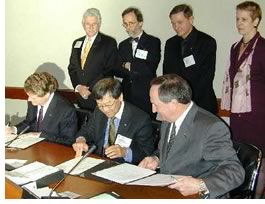
With an eye toward reciprocal recognition of professional licensure in the U.S. and European Union, representatives from the AIA, Architect’s Council of Europe (ACE), and National Council of Architectural Registration Boards (NCARB) ceremonially signed an Accord on Cooperation and Professionalism in Architecture December 6 in Washington, D.C.
The accord calls for agreement among the three organizations on issues such as the education, training, and licensure of architects to protect public health, safety, and welfare as well as social, architectural, environmental and cultural heritage. The immediate goal is to reach a Mutual Recognition Agreement over the next 12 months, at which time the three organizations will turn to their respective governments to establish formal international agreements that would recognize U.S. and European architects as qualified to practice in each other’s jurisdictions.
 The
accord was formally signed by the president, president-elect, and executive
officer of each organization prior to the ceremony by exchange of express
courier letters. Present at the ceremony were Juhani Katainen, Hon. AIA,
of Finland, ACE president; C. Robert Campbell, AIA, NCARB president; Robert
A. Boynton, FAIA, NCARB president-elect; Lenore M. Lucey, FAIA, NCARB
executive vice president; Gordon H. Chong, FAIA, AIA president; Thompson
E. Penney, FAIA, AIA president-elect; and Norman L. Koonce, FAIA, AIA
executive vice president/CEO.
The
accord was formally signed by the president, president-elect, and executive
officer of each organization prior to the ceremony by exchange of express
courier letters. Present at the ceremony were Juhani Katainen, Hon. AIA,
of Finland, ACE president; C. Robert Campbell, AIA, NCARB president; Robert
A. Boynton, FAIA, NCARB president-elect; Lenore M. Lucey, FAIA, NCARB
executive vice president; Gordon H. Chong, FAIA, AIA president; Thompson
E. Penney, FAIA, AIA president-elect; and Norman L. Koonce, FAIA, AIA
executive vice president/CEO.
The signing of this accord marks the culmination of three years of work on the part of the signatories, begun under the impetus of an intergovernmental trade initiative, the Transatlantic Economic Partnership. The initiative sought just such an agreement on mutual recognition of professional qualifications of architects. This accord will promote the mobility of architects between the European Union and the U.S., and facilitate international trade in architectural services.
The Accord on Co-operation and Professionalism in Architecture defines the basic principles of a mutual recognition agreement. The specific terms and conditions and the implementation procedures will be defined by a joint Mutual Recognition Agreement drafting panel over the next year.
Currently, the U.S. has an agreement on full mutual recognition with only one other country, Canada. Negotiations on this agreement were begun under the impetus of the U.S.-Canada Free Trade Agreement. The AIA signed the Accord on Professionalism in Architecture with Canada in 1987. The subsequent agreement between NCARB and the CCAC (Committee of Canadian Architectural Councils) concluded in 1994.
Established in 1990, the Architects’ Council of Europe is the representative body for the architectural profession in the European Union. Its membership is drawn from national registration and professional architectural organizations from most of the EU Member States. ACE also has members from two European Economic Area States and “observer members” from several of the Accession States currently negotiating to join the EU. In total, ACE represents about 350,000 European architects. It is headquartered in Brussels.
NCARB represents the registration authorities of the 55 states and territories of the U.S., and the AIA represents the profession of architecture in the U.S.
Copyright 2002 The American Institute of Architects. All rights reserved.
![]()
| NCARB President C. Robert Campbell, AIA (standing at left); NCARB President-elect Robert A. Boynton, FAIA; ACE President Juhani Katainen, Hon. AIA; and NCARB Executive Vice President Lenore Lucy, FAIA look on as (seated) AIA 2003 President Thompson E. Penney, FAIA; 2002 President Gordon H. Chong, FAIA; and AIA Executive Vice President/CEO Norman L. Koonce, FAIA, sign the accord. Click here for the full text of the ACE/NCARB/AIA Accord on Cooperation and Professionalism in Architecture. (120 kb PDF file) |
|